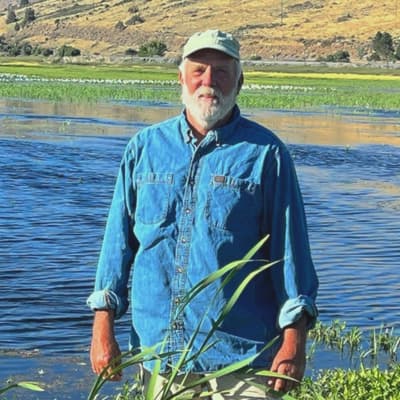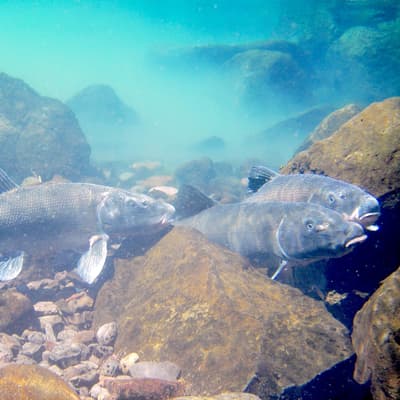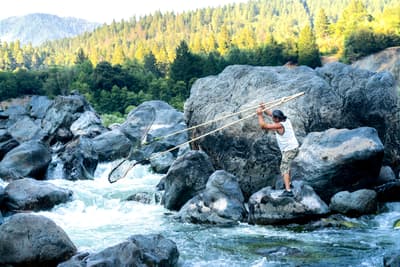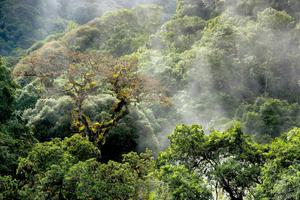When a field is returned to production after three years under water, weeds and pests have been drowned and soil health is improved.
The success of Lakeside’s wetland restoration is only the splashiest of recent positive developments in the Klamath River watershed, which has long been plagued by battles over water quality, water allocation, and the plight of native fish. In the first month after the completion last fall of the world’s largest dam removal project on the Klamath River, more than 6,000 salmon swam upstream past the dam sites, far exceeding biologists’ expectations and reinforcing hope for a broad recovery of deeply depleted salmon stocks. The salmons’ entrance into the upper basin, where they had not circulated for more than a century, seemed to symbolize the interconnectedness of the watershed, inspiring former adversaries to meet and plan next steps in the restoration of the badly degraded river.
Members of the Klamath Tribes of Oregon, which consists of three tribes, once ate voluminous quantities of the two sucker species — known to them as c’waam and koptu — and held ceremonies to honor the fish. Many members live close to Upper Klamath Lake, the basin’s biggest lake and home to most of the surviving suckers.
The tribes, which have senior water rights to the lake, have kept its levels close to full in an effort to boost c’waam and koptu survival. That policy has angered farmers at the southern end of Upper Klamath Lake, who receive less water for their crops. For their part, the Yurok and Karuk tribes in the lower basin argue that they have been shortchanged in water allocations, and that smaller water releases spread fish disease and deplete the health of salmon, the fish at the heart of their cultures. Amid these long-running tensions, the news that wetlands restoration had helped suckers survive raised many Klamath residents’ hopes: The tribes envisioned more fish; the farmers envisioned more irrigation water.
Some farmers resist wetland restoration because it requires taking acreage out of production. But Wenner maintains that, actually, farmers benefit. Lakeside rotates its wetland among its four fields. When a field is returned to production after three years under water, Wenner said, its weeds and pests have been drowned; soil health has improved; fewer chemical inputs are needed; and the field’s produce can be classified as organic, increasing its value. The farm also receives funding from the Natural Resources Conservation Service for creating a wetland beneficial to migratory birds.
Wenner’s experiment has shown that a combination of wetlands and agriculture “can lead to a more resilient watershed where abundant fish, wildlife, and better water quality are not divergent outcomes,” said Jeff McCreary, operations director for Ducks Unlimited’s western region. Moreover, the collaborations that benefit wildlife, agriculture, and a range of cultural values, he said, can “lift up all in the community.”
Wenner’s achievement is rooted in the power of wetlands, which are critical components of well-functioning hydrological systems. With their spongy composition, they moderate potential natural disasters by retaining water during floods and releasing it during droughts. They also act as filters, absorbing nutrients like phosphorus, whose overabundance in Upper Klamath Lake is driving the decline of c’waam and koptu.
Historically, wetlands around the lake provided a protected habitat for juvenile c’waam and koptu to reach maturity before they ventured, as adults, into Upper Klamath Lake, where predators are plentiful. But today, roughly 95 percent of the basin’s wetlands are gone, and since the mid-1990s, no juvenile c’waam or koptu have survived to adulthood in Upper Klamath Lake. Of the millions of suckers that once resided in upper basin waters, fewer than 40,000 c’waam and koptu remain, according to biologists’ estimates, and these fish are aging out.
A surfeit of phosphorus leads to algae blooms, which consume enough oxygen to prevent juvenile suckers from reaching adulthood.
Phosphorus wasn’t a problem in Upper Klamath Lake until farmers, ranchers, and the U.S. government, beginning more than a century ago, reconfigured the upper basin’s hydrology to promote agriculture. When, for example, the Army Corps of Engineers, in the 1950s, straightened and diked the banks of the meandering Sprague River, a principal tributary of Upper Klamath Lake, it prevented flooding of ranchers’ pastures that bordered the river, but it also turned the Sprague into a superhighway that scoured naturally occurring phosphorus from soils and sent it into Upper Klamath Lake. Now that surfeit of phosphorus leads to the formation each summer of toxic blue-green algae blooms, which consume enough of the lake’s oxygen to prevent juvenile suckers from reaching adulthood.
Wenner’s fish experiment began with the stocking of nearly 5,500 juvenile suckers in April 2022. This past May, the wetland was partially drained to determine whether any had survived to adulthood. To biologists’ delight, they found 50, and may have missed many more. More tantalizing still, these fish were both bigger — up to 16 inches long — and healthier than adult suckers that remained in hatcheries.
Genetic testing will now determine how many are c’waam and koptu, as opposed to another local non-endangered fish, the Klamath largescale sucker. But it is likely that most are c’waam and koptu, Wenner said after consulting with fish biologists. No single approach can solve all the problems of a hydrological system as complicated as the Klamath’s, but Wenner’s experiment has shown that accelerated wetland restoration could be a valuable tool in enabling suckers to reach adulthood.
Left: Karl Wenner at a restored wetland at Lakeside Farms. Right: Lost River suckers in Upper Klamath Lake, Oregon. Karl Wenner; Brian Hayes / USGS
Even before the success at Lakeside, wetlands restoration was catching on in the upper basin. Last summer the Klamath Tribes breached a dike to reflood 27,000 acres of former wetlands at the Klamath Marsh National Wildlife Refuge, 20 miles north of Upper Klamath Lake. And in December, in the largest freshwater estuary restoration west of the Mississippi River, the Klamath Tribes, Ducks Unlimited, and the U.S. Fish and Wildlife Service oversaw a dike-breaching that led to the flooding of 14,000 acres of former wetland, reconnecting it to Upper Klamath Lake and restoring its ecological functions.
Meanwhile, Wenner’s project is setting off ripples. Two other landowners near Lakeside Farms are considering converting some of their fields to wetlands, and farmers in the Klamath Drainage District south of the lake are said to be interested as well. In a region where acrimony and distrust between tribes on one side and farmers and ranchers on the other have simmered for most of this century, the fact that farmers are trying to help solve the Klamath Tribes’ sucker problem is drawing favorable attention.
“It is quite a story that after 35 years of the Feds having responsibility for keeping these fish from going extinct,” said Jeff Mitchell, former chairman of the Klamath Tribes of Oregon, “the parties that [succeeded] are the two entities — the tribes and ag — that have had a very contentious history.”
Federal layoffs will likely make impossible the gathering of data on river flows, fish populations, and fish disease that is vital for planning.
Basin residents have formed at least 10 working groups to devise solutions for specific Klamath environmental problems. Group membership is overlapping, facilitating the dissemination of ideas. One working group that includes both farmers and tribal members is planning how to revive and reconnect one of the upper basin’s drained lakes to the Klamath River, from which it was separated more than a century ago.
Consideration is also being given to an even more ambitious plan, which would enable water to flow from Upper Klamath Lake through farmland and wildlife refuges all the way back to the Klamath River. Both schemes would restore parts of the basin’s former hydrology and would enhance fish recovery and water quality.
Nearly two decades ago, in an arduous two-year negotiation that ultimately collapsed, Klamath farmers, tribal leaders, environmentalists, and government officials hammered out a plan to fairly allocate water between farmlands and fish. But the spirit of those talks was zero-sum, as participants calculated what they had to give up in order to get what they wanted. By contrast, participants in the working groups say their goal is to collaborate on projects in which all the basin’s key constituents benefit from a thriving hydrological system.
A Karuk tribal member fishes for salmon on the Klamath River. Melina Mara / The Washington Post via Getty Images
To be sure, there is one dark cloud that hovers over all these positive developments: the Trump administration’s recent funding cuts and layoffs of federal personnel in the Klamath basin. The funding cuts, which have struck at both tribal budgets and ongoing river restoration projects, have created a crisis that some local officials call dire.
Layoffs of workers in the U.S. Fish and Wildlife Service and the U.S. Geological Survey probably will make impossible the gathering of data on river flows, fish populations, and fish disease that is vital for planning everything from fish recovery projects to preparations for flood emergencies. Valuable information on the effects of the Klamath dam removal project could go uncollected, impairing planning for future dam removals.
But despite all this, tribal leaders say dam removal has generated so much momentum that progress towards a healthy river system cannot be stopped. “We’ve done a lot of work over the past five to 10 years to strengthen communities up and down the basin so that regardless of what administration is in D.C., we’ll be working collaboratively,” said Frankie Myers, vice-chairman of the coastal Yurok tribe, California’s largest, and the basin’s most influential, tribe. “I think what we have and what we’re building is strong enough to get us through.”







